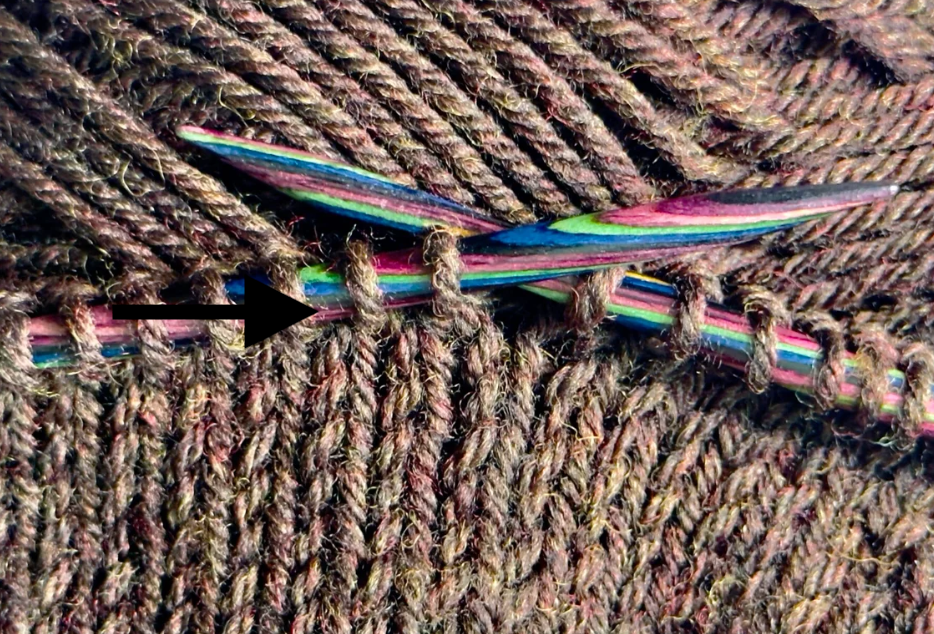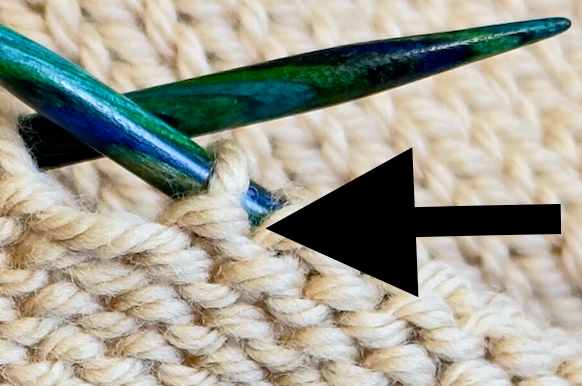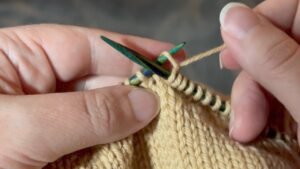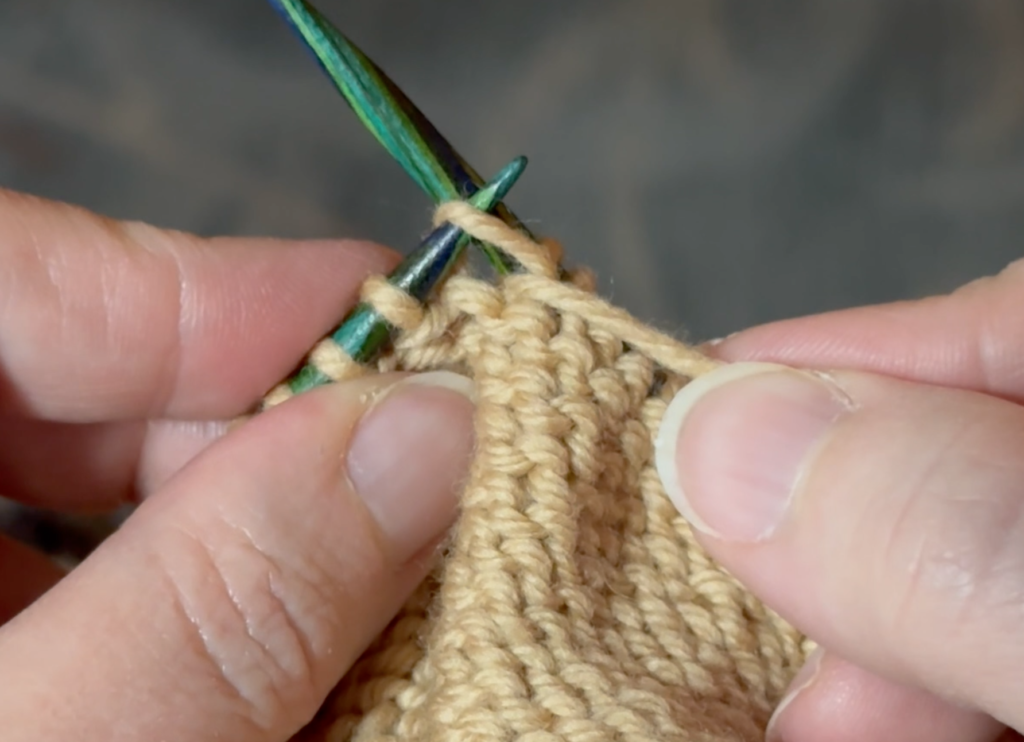Everyone makes mistakes, especially when taking on a craft such as knitting. Knowing how to un-do, aka “tink” your knitting is a valuable skill to have. As part of knowing how to tink, you should also learn how to “read” your knitting. Reading your knitting involves being able to recognize not only your basic stitches such as knit and purl, but as you start knitting more and more complex patterns, there will be yarn overs, slipped stitches, twisted stitches, cables, etc.
When I first started knitting I had a hard time recognizing which stitch was which, and that made it especially difficult to un-do what I had knitted. As a result, I would get incredibly frustrated and ended up making mistakes as I tinked back a row. This led to the dreaded “frogging” of the entire project. Frogging refers to simply tearing out entire rows, sometimes to the very beginning, resulting in having to start over from scratch.
Reading Your Knitting
Before tinking, I suggest taking the time to learn each of your stitches and how they look on the needle. For example, below you see examples of the knit stitch and purl stitch. The knit stitch looks like a V from the right side while the purl stitch looks like a “bump” that is hugging the needle. When you are looking at the knit stitch from the right side, you will also notice that on the wrong side it has the bump, this is because the two stitches are opposites of each other.
It sounds simple, but when I first started knitting, the concept of reading my knitting had not yet occurred to me. Therefore, when I made mistakes and had to pull back my stitches, I often ended up making more mistakes. Start with recognizing the knit and purl stitches but as you gain confidence you will know what other stitch types look like and how they are mounted on the needle.


Stitch Orientation
 The stitch orientation, or how the stitch is mounted, is also very important. As you look at a knit stitch, notice that there are two “legs” to the stitch. The leading leg should be in the front and the trailing leg in the back. If you knit into the stitch when it is mounted the opposite way you will actually end up twisting the stitch as it is placed on the right hand needle. You can also tell that it is mounted incorrectly if it is not as easy to slide your needle into the stitch and knit into it. The stitch will twist as you make the stitch.
The stitch orientation, or how the stitch is mounted, is also very important. As you look at a knit stitch, notice that there are two “legs” to the stitch. The leading leg should be in the front and the trailing leg in the back. If you knit into the stitch when it is mounted the opposite way you will actually end up twisting the stitch as it is placed on the right hand needle. You can also tell that it is mounted incorrectly if it is not as easy to slide your needle into the stitch and knit into it. The stitch will twist as you make the stitch.
Tink the Knit Stitch
 Now that you can recognize both the knit and purl stitches on your needle, it is time to start tinking them. For the knit stitch, pick up the loop that is behind the needle from left to right and pull off the stitch.Once you know which direction to take a stitch off your right-hand needle, it is easy to undo as many stitches as needed. Check out the videos below for a demonstration.
Now that you can recognize both the knit and purl stitches on your needle, it is time to start tinking them. For the knit stitch, pick up the loop that is behind the needle from left to right and pull off the stitch.Once you know which direction to take a stitch off your right-hand needle, it is easy to undo as many stitches as needed. Check out the videos below for a demonstration.
Tink the Purl Stitch
 For the purl stitch, insert your needle into the front of that next stitch from left to right and pull it off of your needle. Once again, be careful to mount the stitch correctly on your left hand needle. If you have trouble recognizing its orientation for the first few tinked stitches, turn your work around to see how the stitches look from the knit side. Check that they are mounted with the leading leg in the front and the trailing leg in the back.
For the purl stitch, insert your needle into the front of that next stitch from left to right and pull it off of your needle. Once again, be careful to mount the stitch correctly on your left hand needle. If you have trouble recognizing its orientation for the first few tinked stitches, turn your work around to see how the stitches look from the knit side. Check that they are mounted with the leading leg in the front and the trailing leg in the back.
Continue tinking stitches as far back as you need to go. Theoretically, you could do so for multiple rows, but it does become tedious for large sections of knitting. It can also be difficult if there are more than just simple knit and purl stitches. I have found myself getting very frustrated when I have to tink back a complicated section of the pattern, especially if it involves cables. It can be done, but not without some frustration!
What if you’ve made a mistake several rows back? You can pull back entire rows of stitches, otherwise know as “frogging” instead of tinking each stitch one by one.
Alternative: Add a Lifeline Instead of Tinking each Stitch
I mentioned the tedium involved in ticking multiple rows of knitting, so what is the alternative, especially for more complex patterns? I would suggest adding what is called a “lifeline,” at various points. There are a couple of different ways to do so:
- Using a tapestry needle, thread a piece of scrap yarn through each stitch in the row. Be careful to do so under the right leg or leading leg of each stitch to keep them mounted correctly.
- If using circular needles, there should be a small hole at the base of the needle where you can tie a long piece of sewing thread. As you knit the row, the thread will be pulled through the knitting as you go.
Alternative: Place Needle through a Previous Row and "Frog"
There is a mistake several rows back but you didn’t place a lifeline, now what? You can actually place a knitting needle through your stitches in any previous row and then frog all the stitches. It is a good idea to use a needle that is smaller than what your stitches have been made with, simply for ease of getting the needle into all of the stitches. Start at the beginning of a previous row and place your new needle into the right leg of each and every stitch in that row. It’s important that it is the right leg of each stitch in order for the stitches to be mounted correctly. You can fix it if you mistakenly pick up the left leg of a stitch by re-orienting the stitch when you come to it. When you pull back your stitches to that row on the new needle, the live stitches will be ready to knit again.

